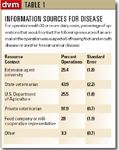DVM opportunities stem from dairy farm biosecurity
USDA offers guidance to developing a formal biosecurity plan.
WASHINGTON— U.S. dairy operations are lacking when it comes to biosecurity, and veterinarians are the professionals most apt to educate managers.
That finding was released as part of a recent study by the United States Department of Agriculture's (USDA) National Animal Health Monitoring System (NAHMS). The interpretative report, titled "Animal disease exclusion practices on U.S. dairy operations, 2002," takes an in-depth look at biosecurity practices among the nation's veterinary farms, addressing issues such as strategies for Johne's disease; management factors associated with the presence of food safety pathogens and profiling waste-handling systems.

Table 1 Information sources for disease
The reported shortcomings present a perfect platform for food animal practitioners to educate their clients, says Dr. Brian McCluskey, an epidemiologist with the USDA's Centers of Epidemiology and Animal Health.
"Less than 40 percent of producers have any guidelines on visitors; things as simple as foot baths and disposable boots aren't being required," McCluskey says. "We've identified, through this report, these types of shortcomings and gaps, and it's here that dairy practitioners can have a lot of influence and really get involved. It's a service they could provide for the industry."
Veterinarians are educators
The industry, according to the NAHMS report, can be identified as farms within 21 states, representing 83 percent of all U.S. dairy operations and 85.7 percent of U.S. dairy cows. Study data collected from Dec. 31, 2001, through Feb. 12, 2002, reveals most producers aren't knowledgeable about anthrax and screwworm. Eighty-three percent of those polled report never before hearing the term "vesticular stomatitis," and 95.1 percent of respondents claim they are ignorant about heartwater disease.
By contrast, more than half of those polled say they know the basics about foot and mouth disease, and if an outbreak of foreign animal disease occurred in the United States, they would consult a DVM (see Table 1).
"Most dairy producers (97.9 percent) reported that if they suspected a foreign animal disease on their operation, they would contact their veterinarian," the report says. "Less than half of producers (43.9 percent) would contact the state veterinarian's office. These responses highlight the continuing need to educate veterinary practitioners about how to identify and handle suspected foreign diseases on livestock operations."
Development of a biosecurity plan
For veterinarians seeking information on how to aid their clients in disease prevention, USDA offers guidance to developing a formal biosecurity plan, described as "an exercise in risk assessment."
According to the NAHMS report, four steps should be included in the assessment process:
- Hazard identification: The preliminary step in designing a biosecurity plan is to assess the specific risks for the operation. Suggestions include identifying a chief source of income, most likely milk on dairy farms. Diseases that threaten the production of milk should have the highest priority.
- Exposure assessment: Operations must identify which specific diseases are most likely to be hazards for their particular farm and identify how cattle would be exposed. Factor to consider include geographic location; rodent, insect and bird populations; wind and weather patterns; disease history; proximity to other livestock operations; wildlife contacts; prospective visitors; off-site animal travel; and the addition of new animals.
- Risk characterization: Once potential hazards have been identified, the degree of risk must be characterized for the operation. This qualitative assessment can be done alongside exposure assessment. For example, operations that replace heifers have a higher risk of introducing infectious disease to the herd than those that do not make off-site animal purchases. In addition, dairies that allow the same employees to work with calves, sick cows and do milking chores have a higher potential risk of disease spread. Vaccine availability and efficacy for certain diseases must also be considered.
- Identification of mitigations: All information attained from the first three steps should be absorbed into a final plan for mitigation, which should include the diseases of utmost importance, direction of control efforts, a plan to assess current levels of disease (serologic or fecal testing), and written strategies detailing what will be done to prevent the introduction and spread of infectious disease.
Points for consideration
Small dairy operations are less likely to have biosecurity measures in place than production facilities with larger herds, the report says. According to the study's data on vaccination practices, large operations inoculate against all major diseases including bovine viral diarrhea and Salmonella much more frequently than smaller outfits. For larger and smaller operations, vaccination for Mycobacterium paratuberculosis (Johne's disease) was logged at 4.1 percent.
That represents a huge educational opportunity for veterinarians, McCluskey says.
"Generally, the larger herds are more likely to have management practices in place that would prevent disease spread," McCluskey says. "It's economy of scale; the cost of vaccinating is much less if you have 2,000 animals versus 200. Veterinarians should be convincing producers that there are benefits to disease prevention, whether you have a small or large herd. I think this is where practitioners can have a lot of influence."